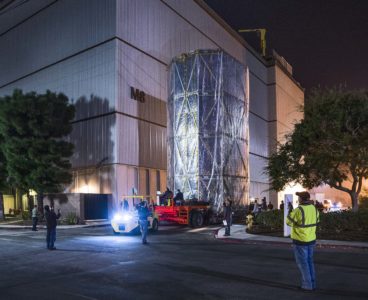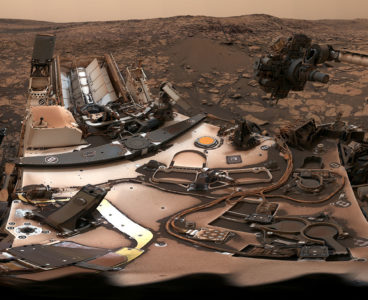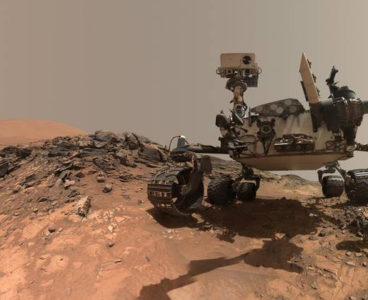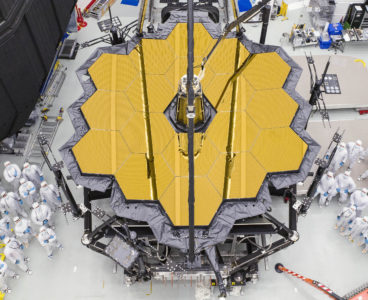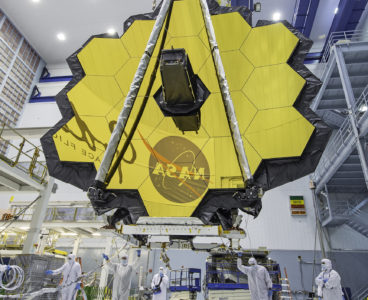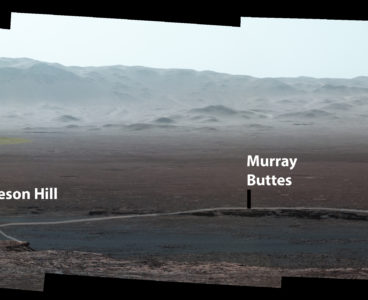NASA’s Mars 2020 spacecraft has completed acoustic and thermal vacuum (TVAC) testing at the Jet Propulsion Laboratory in Pasadena, California. The acoustic test of the spacecraft that will carry the Mars 2020 rover to a soft touchdown in Jezero Crater on Feb. 18, 2021, is the best Earthly approximation for what the spacecraft will endure…
Mars 2020 Spacecraft Prepped for Launch in NASA Cleanroom
For the past few months, the cleanroom floor in High Bay 1 at NASA’s Jet Propulsion Laboratory in Pasadena, California, has been covered in parts, components and test equipment for the Mars 2020 spacecraft, scheduled for launch toward the Red Planet in July of 2020. But over the past few weeks, some of these components—the…
NASA Space Telescope Wrapped in a Mobile Cleanroom
Before moving NASA’s James Webb Space Telescope, and to assure that it’s kept clean and safe, Webb got a very special wrapping treatment. The wrapping acts as a “mobile cleanroom,” safeguarding the technological marvel from contaminants. All satellites and observatories are created in cleanrooms. Cleanrooms filter out harmful contaminants, as even a speck of dust…
In Search of Missing Worlds, Hubble Finds a Fast Evaporating Exoplanet
Fishermen would be puzzled if they netted only big and little fish, but few medium-sized fish. Astronomers likewise have been perplexed in conducting a census of star-hugging extrasolar planets. They have found hot Jupiter-sized planets and hot super-Earths (planets no more than 1.5 times Earth’s diameter). These planets are scorching hot because they orbit very…
Curiosity to Study Possible Meteorite on Mars Surface
Curiosity woke up to Mr Rogers’ “Please would you be my neighbour” this morning to welcome InSight, and then got busy at the Highfield drill site. Curiosity will dump the Highfield sample, which requires several MAHLI looks and an APXS operation, but the plan also requires swinging the arm out of the way so other…
Curiosity Rover to Temporarily Switch ‘Brains’
Engineers at NASA’s Jet Propulsion Laboratory in Pasadena, California, this week commanded the agency’s Curiosity rover to switch to its second computer. The switch will enable engineers to do a detailed diagnosis of a technical issue that has prevented the rover’s active computer from storing science and some key engineering data since Sept. 15. Like…
NASA Successfully Launches Ice-monitoring Satellite
NASA’s Ice, Cloud and land Elevation Satellite-2 (ICESat-2) successfully launched from California at 9:02 a.m. EDT on Sept. 15, embarking on its mission to measure the ice of Earth’s frozen reaches with unprecedented accuracy. ICESat-2 lifted off from Space Launch Complex-2 at Vandenberg Air Force Base on United Launch Alliance’s final Delta II rocket. Ground…
Curiosity Braves Martian Dust Storms to Collect Samples
After snagging a new rock sample on Aug. 9, NASA’s Curiosity rover surveyed its surroundings on Mars, producing a 360-degree panorama of its current location on Vera Rubin Ridge. The panorama includes umber skies, darkened by a fading global dust storm. It also includes a rare view by the Mast Camera of the rover itself,…
Martian Dust Storm Fades, But Has Opportunity Been Lost?
A planet-encircling dust storm on Mars, which was first detected May 30 and halted operations for the Opportunity rover, continues to abate. With clearing skies over Opportunity’s resting spot in Mars’ Perseverance Valley, engineers at NASA’s Jet Propulsion Laboratory in Pasadena, Calif., believe the nearly 15-year-old, solar-powered rover will soon receive enough sunlight to automatically…
NASA’s Advanced Laser Will Measure Earth’s Changing Ice
Next month, NASA will launch into space the most advanced laser instrument of its kind, beginning a mission to measure — in unprecedented detail — changes in the heights of Earth’s polar ice. NASA’s Ice, Cloud and land Elevation Satellite-2 (ICESat-2) will measure the average annual elevation change of land ice covering Greenland and Antarctica…
Parker Solar Probe Launching to Sun This Weekend
NASA’s historic Parker Solar Probe mission will revolutionize our understanding of the Sun, where changing conditions can propagate out into the solar system, affecting Earth and other worlds. Parker Solar Probe will travel through the Sun’s atmosphere, closer to the surface than any spacecraft before it, facing brutal heat and radiation conditions — and ultimately…
Curiosity Rover Uncovers Organic Material, Mysterious Methane on Mars
NASA’s Curiosity rover has found new evidence preserved in rocks on Mars that suggests the planet could have supported ancient life, as well as new evidence in the Martian atmosphere that relates to the search for current life on the Red Planet. While not necessarily evidence of life itself, these findings are a good sign…
Cleanroom Snapshots: Space Thermal Blankets All Tied Up With String
NASA’s Webb Mission Pushed Back to 2020
NASA’s James Webb Space Telescope currently is undergoing final integration and test phases that will require more time to ensure a successful mission. After an independent assessment of remaining tasks for the highly complex space observatory, Webb’s previously revised 2019 launch window now is targeted for approximately May 2020. “Webb is the highest priority project…
Mars Curiosity Rover Reaches Milestone of Sol 2,000
NASA’s Mars Curiosity rover just hit a new milestone: its two-thousandth Martian day, or sol, on the Red Planet. An image mosaic taken by the rover in January offers a preview of what comes next. Looming over the image is Mount Sharp, the mound Curiosity has been climbing since September 2014. In the center of…
Fly to the Sun Aboard a Microchip
Want to get the hottest ticket this summer without standing in line? NASA is inviting people around the world to submit their names online to be placed on a microchip aboard NASA’s historic Parker Solar Probe mission launching in summer 2018. The mission will travel through the Sun’s atmosphere, facing brutal heat and radiation conditions…
NASA Technology on Display at the Oscars
This past weekend’s Academy Awards were probably the last place most people would look for NASA technology, but it was there: the coveted Oscar trophy is coated in the same gold that helps telescopes glimpse distant galaxies. Gold is useful in space, because it is good at reflecting infrared wavelengths of light, which help to…
Curiosity Tests New Martian Drilling Technique
NASA NASA’s Mars Curiosity rover has conducted the first test of a new drilling technique on the Red Planet since its drill stopped working reliably. This early test produced a hole about a half-inch (1-centimeter) deep at a target called Lake Orcadie — not enough for a full scientific sample, but enough to validate that…
Curiosity Reflects on Its Journey So Far
A panoramic image that NASA’s Curiosity Mars rover took from a mountainside ridge provides a sweeping vista of key sites visited since the rover’s 2012 landing, and the towering surroundings. The view from “Vera Rubin Ridge” on the north flank of Mount Sharp encompasses much of the 11-mile (18-kilometer) route the rover has driven from…
Mars Lander Stretches Its Wings
NASA’s next mission to Mars recently passed a key test, extending the solar arrays that will power the InSight spacecraft once it lands on the Red Planet this November. The test took place at Lockheed Martin Space just outside of Denver, where InSight was built and has been undergoing testing ahead of its launch. The…
NASA Launches Rockets in Alaska to Study Space X-Ray Emissions and Create Polar Mesospheric Cloud
Noxious Ice Cloud Found on Saturn’s Moon
Researchers with NASA’s Cassini mission found evidence of a toxic hybrid ice in a wispy cloud high above the south pole of Saturn’s largest moon, Titan. The finding is a new demonstration of the complex chemistry occurring in Titan’s atmosphere—in this case, cloud formation in the giant moon’s stratosphere—and part of a collection of processes…
Small Collisions Make Big Impact on Mercury’s Thin Atmosphere
Mercury, our smallest planetary neighbor, has very little to call an atmosphere, but it does have a strange weather pattern: morning micro-meteor showers. Recent modeling along with previously published results from NASA’s MESSENGER spacecraft — short for Mercury Surface, Space Environment, Geochemistry and Ranging, a mission that observed Mercury from 2011 to 2015 — has shed new…
NASA Telescope Launch Pushed Back to 2019
NASA’s James Webb Space Telescope now is planning to launch between March and June 2019 from French Guiana, following a schedule assessment of the remaining integration and test activities. Previously Webb was targeted to launch in October 2018. “The change in launch timing is not indicative of hardware or technical performance concerns,” says Thomas Zurbuchen,…
NASA Offers Video Tour of Satellite Cleanroom
NASA recently released a video of an in-depth look into a cleanroom at NASA’s Goddard Space Flight Center, where the ICESat-2 satellite is currently being monitored. To view the video, click here. Here, engineers and technicians take special precautions to make sure the instrument’s lasers, mirrors, and other components stay perfectly clean. ICESat-2’s sole instrument…



